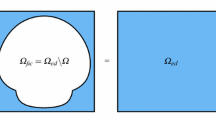Abstract
In the finite cell method, the fictitious domain approach is combined with high-order finite elements. The geometry of the problem is taken into account by integrating the finite cell formulation over the physical domain to obtain the corresponding stiffness matrix and load vector. In this contribution, an extension of the FCM is presented wherein both the physical and fictitious domain of an element are simultaneously evaluated during the integration. In the proposed extension of the finite cell method, the contribution of the stiffness matrix over the fictitious domain is subtracted from the cell, resulting in the desired stiffness matrix which reflects the contribution of the physical domain only. This method results in an exponential rate of convergence for porous domain problems with a smooth solution and accurate integration. In addition, it reduces the computational cost, especially when applying adaptive integration schemes based on the quadtree/octree. Based on 2D and 3D problems of linear elastostatics, numerical examples serve to demonstrate the efficiency and accuracy of the proposed method.





























Similar content being viewed by others
References
Abedian A, Parvizian J, Düster A, Khademyzadeh H, Rank E (2013) Performance of different integration schemes in facing discontinuities in the finite cell method. Int J Comput Methods 10(3):1350002/1–24
Abedian A, Parvizian J, Düster A, Rank E (2013) The finite cell method for the J\(_2\) flow theory of plasticity. Finite Elem Anal Des 69:37–47
Cools R, Kim KJ (2000) A survey of known and new cubature formulas for the unit disk. Korean J Comput Appl Math 7(3):477–485
Düster A, Bröker H, Heidkamp H, Heißerer U, Kollmannsberger S, Wassouf Z, Krause R, Muthler A, Niggl A, Nübel V, Rücker M, Scholz D (2004) AdhoC\(^4\)—user’s guide. Technische Universität München, Lehrstuhl für Bauinformatik
Düster A, Parvizian J, Yang Z, Rank E (2008) The finite cell method for three-dimensional problems of solid mechanics. Comput Methods Appl Mech Eng 197:3768–3782
Fries TP, Omerović S (2016) Higher-order accurate integration of implicit geometries. Int J Numer Methods Eng 106(5):323–371
Garcia-Ruiz MJ, Steven GP (1999) Fixed grid finite elements in elasticity problems. Eng Comput 16(2):145–164
Hu N, Wang B, Tan GW, Yao ZH, Yuan WF (2000) Effective elastic properties of 2-D solids with circular holes: numerical simulations. Compos Sci Technol 60(9):1811–1823
Isida M, Igawa H (1991) Analysis of a zig-zag array of circular holes in an infinite solid under uniaxial tension. Int J Solids Struct 27(7):849–864
Joulaian M, Hubrich S, Düster A (2016) Numerical integration of discontinuities on arbitrary domains based on moment fitting. Comput Mech 57:979–999
Kudela L, Zander N, Kollmannsberger S, Rank E (2016) Smart octrees: accurately integrating discontinuous functions in 3D. Comput Methods Appl Mech Eng 306:406–426
Li B, Wang B, Reid SR (2010) Effective elastic properties of randomly distributed void models for porous materials. Int J Mech Sci 52(5):726–732
Müller B, Kummer F, Oberlack M (2013) Highly accurate surface and volume integration on implicit domains by means of moment-fitting. Int J Numer Methods Eng 96:512–528
Neittaanmäki P, Tiba D (1995) An embedding of domains approach in free boundary problems and optimal design. SIAM J Control Optim 33(5):1587–1602
Paiboon J, Griffiths DV, Huang J, Fenton GA (2013) Numerical analysis of effective elastic properties of geomaterials containing voids using 3D random fields and finite elements. Int J Solids Struct 50(20):3233–3241
Parvizian J, Düster A, Rank E (2007) Finite cell method-h- and p-extension for embedded domain problems in solid mechanics. Comput Mech 41:121–133
Ramière I, Angot P, Belliard M (2007) A fictitious domain approach with spread interface for elliptic problems with general boundary conditions. Comput Methods Appl Mech Eng 196:766–781
Ruess M, Schillinger D, Bazilevs Y, Varduhn V, Rank E (2013) Weakly enforced essential boundary conditions for NURBS-embedded and trimmed NURBS geometries on the basis of the finite cell method. Int J Numer Methods Eng 95(10):811–846
Saul’ev VK (1963) On solution of some boundary value problems on high performance computers by fictitious domain method. Siberia Math J 4:912–925
Schillinger D, Ruess M, Zander N, Bazilevs Y, Düster A, Rank E (2012) Small and large deformation analysis with the p- and B-spline versions of the finite cell method. Comput Mech 50:445–478
Szabó BA, Babuška I (1991) Finite element analysis. Wiley, London
Szabó BA, Düster A, Rank E (2004) The p-version of the finite element method. In: Stein E, de Borst R, Hughes TJR (eds) Encyclopedia of computational mechanics, vol 1. Wiley, London, pp 119–139 (Chapter 5)
Acknowledgements
This work has been supported by the Alexander von Humboldt Foundation. This support is gratefully acknowledged.
Author information
Authors and Affiliations
Corresponding author
Rights and permissions
About this article
Cite this article
Abedian, A., Düster, A. An extension of the finite cell method using boolean operations. Comput Mech 59, 877–886 (2017). https://doi.org/10.1007/s00466-017-1378-3
Received:
Accepted:
Published:
Issue Date:
DOI: https://doi.org/10.1007/s00466-017-1378-3




